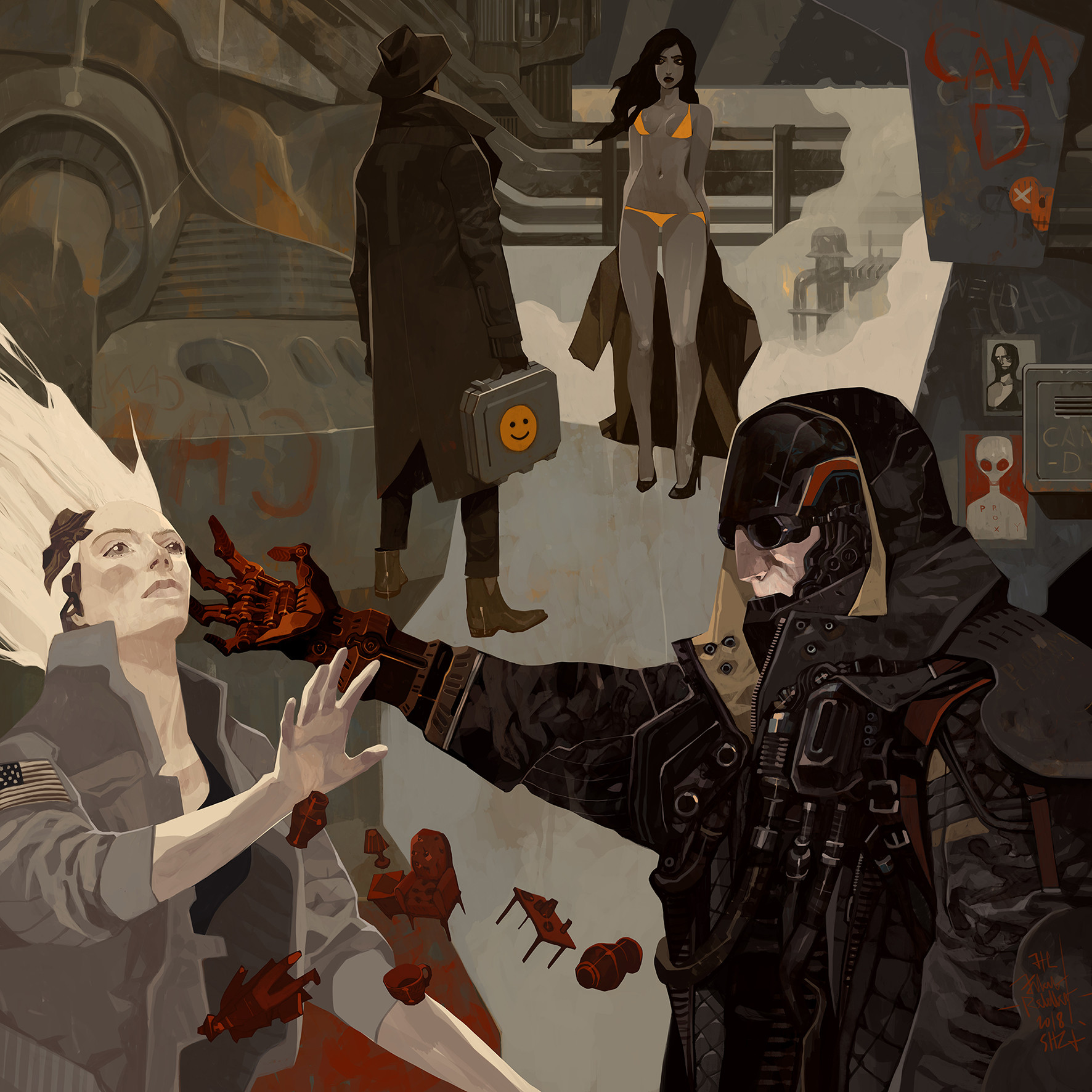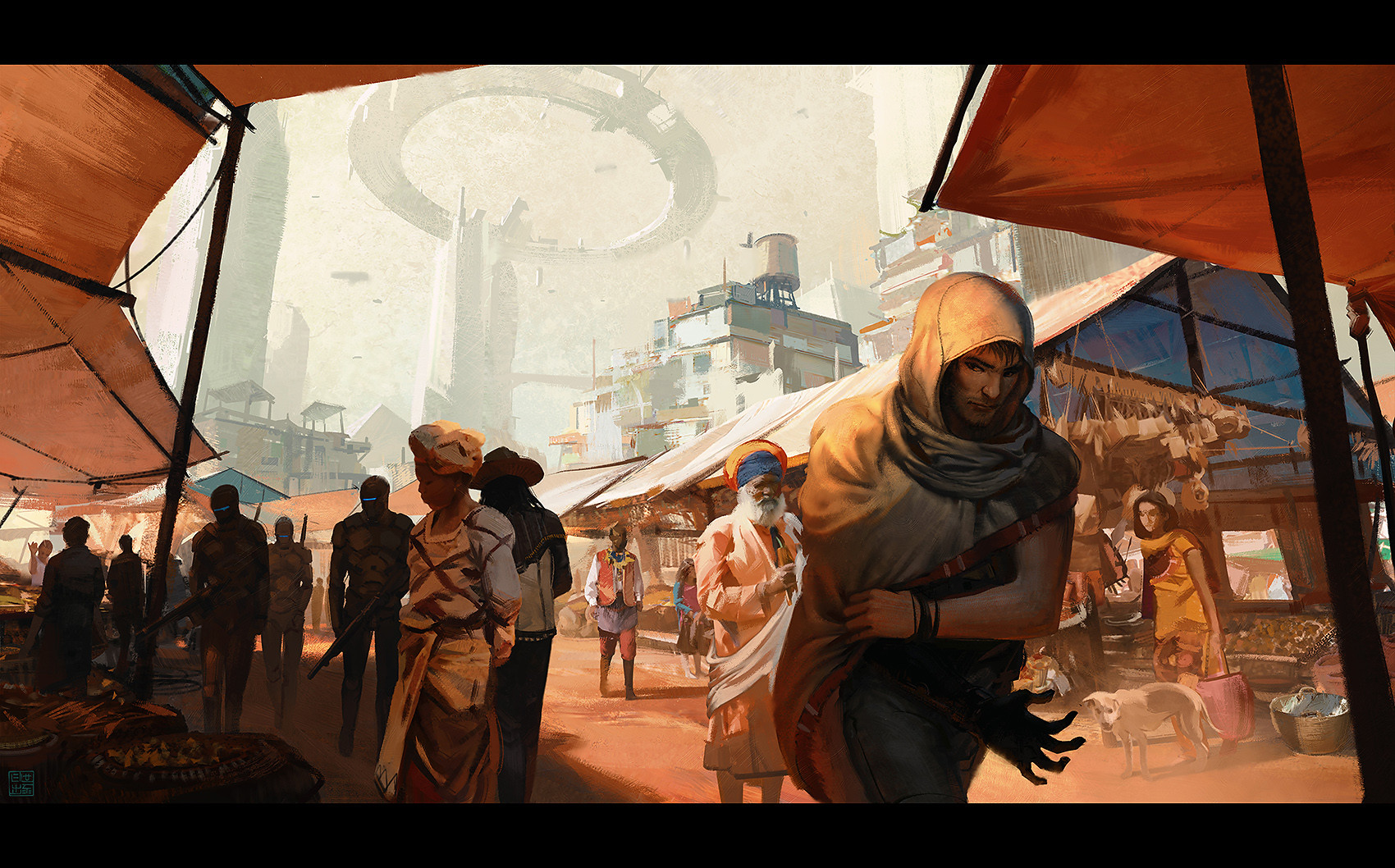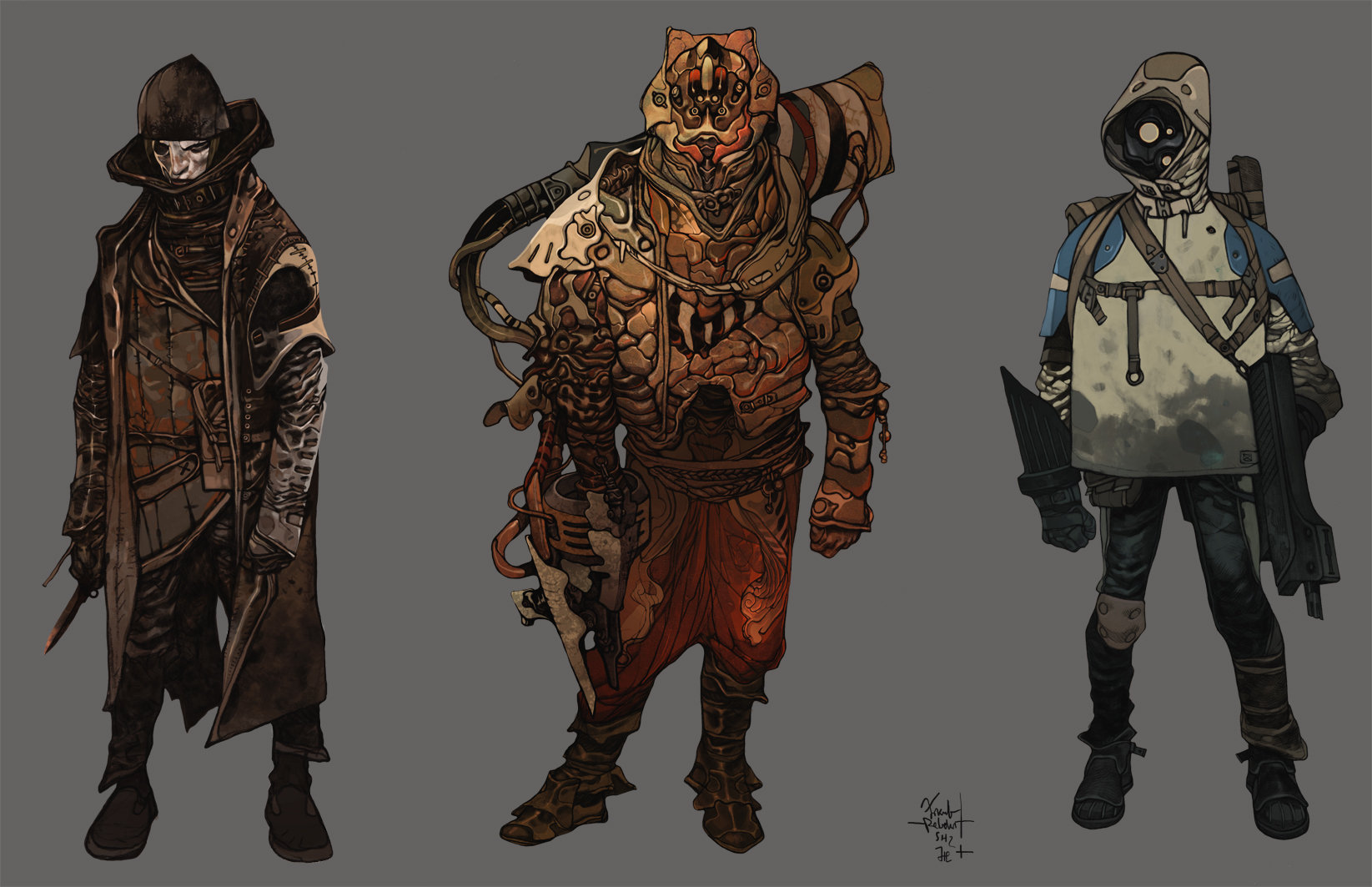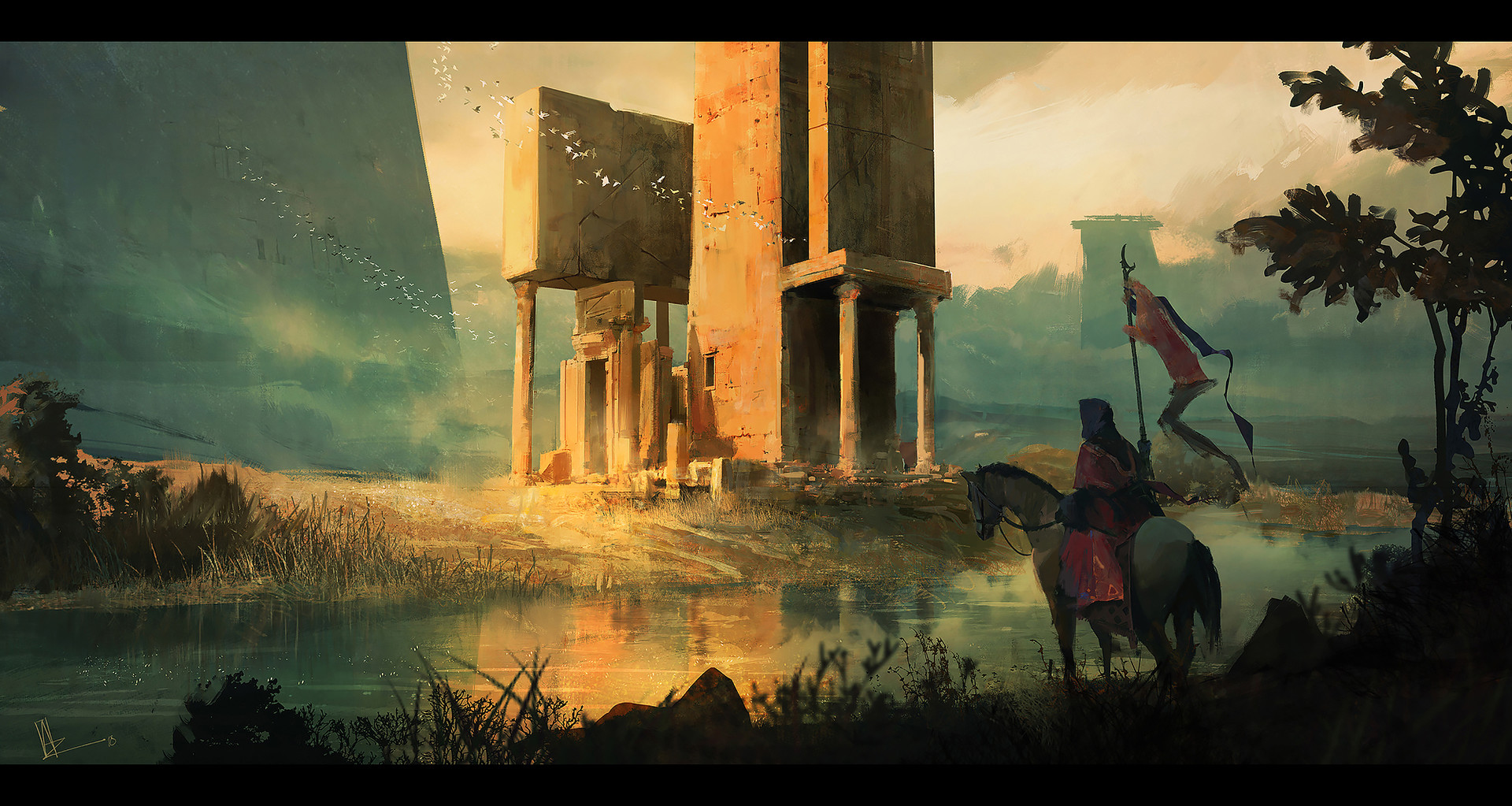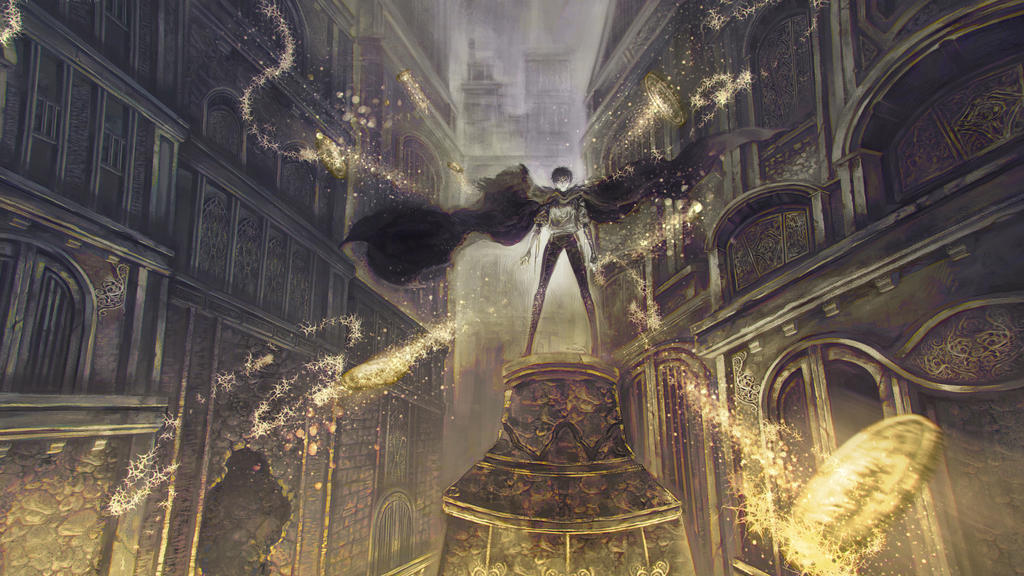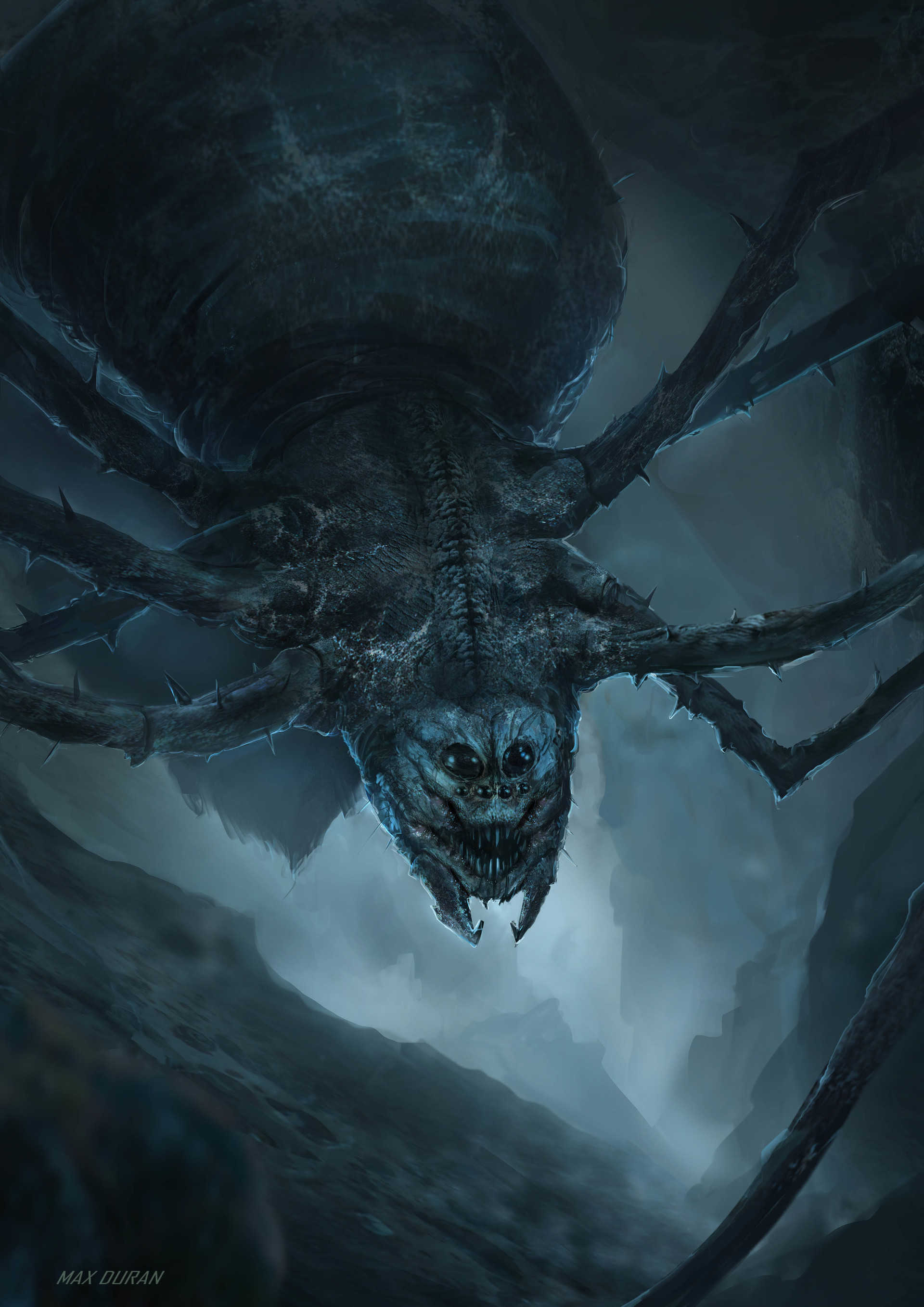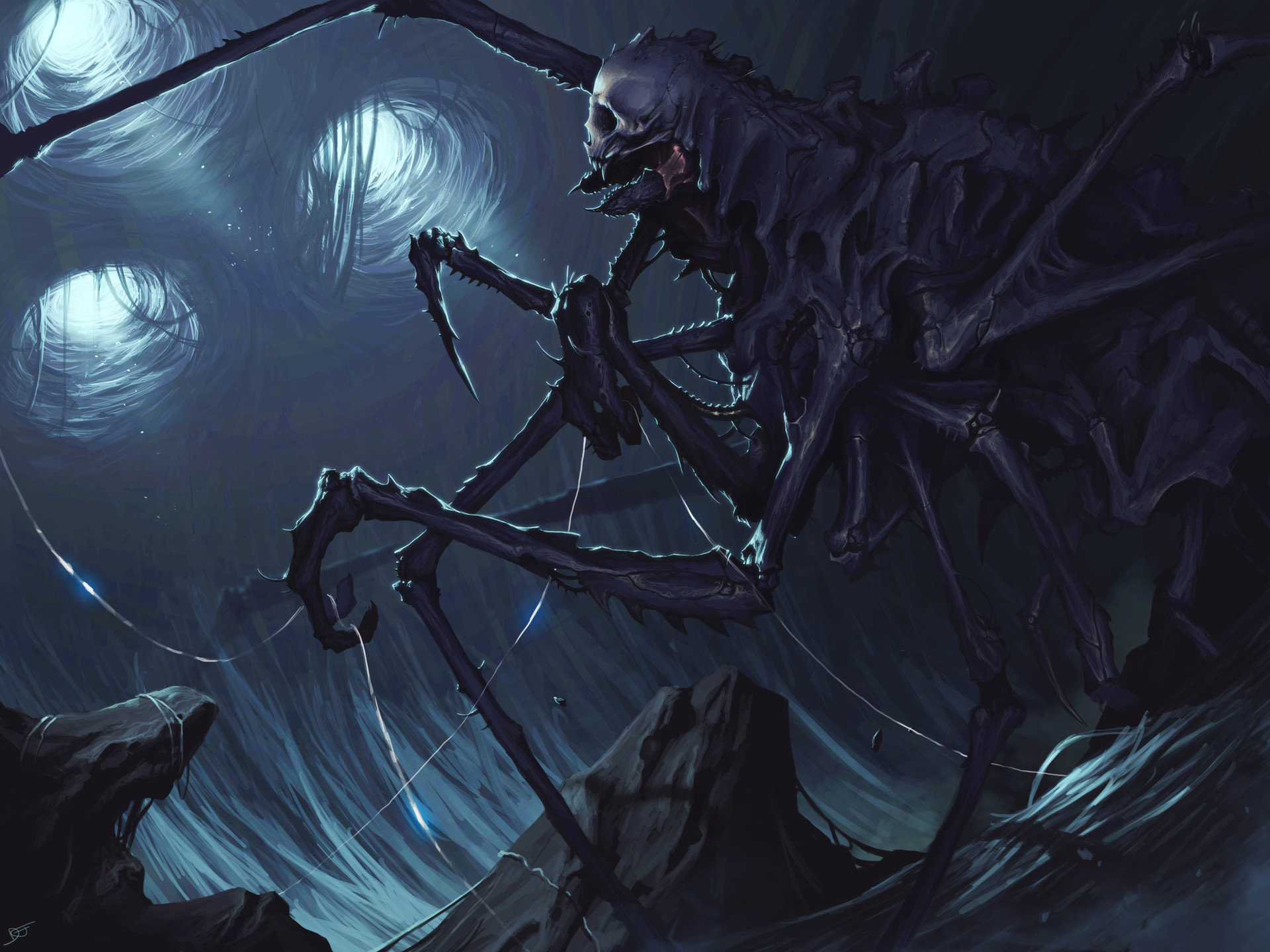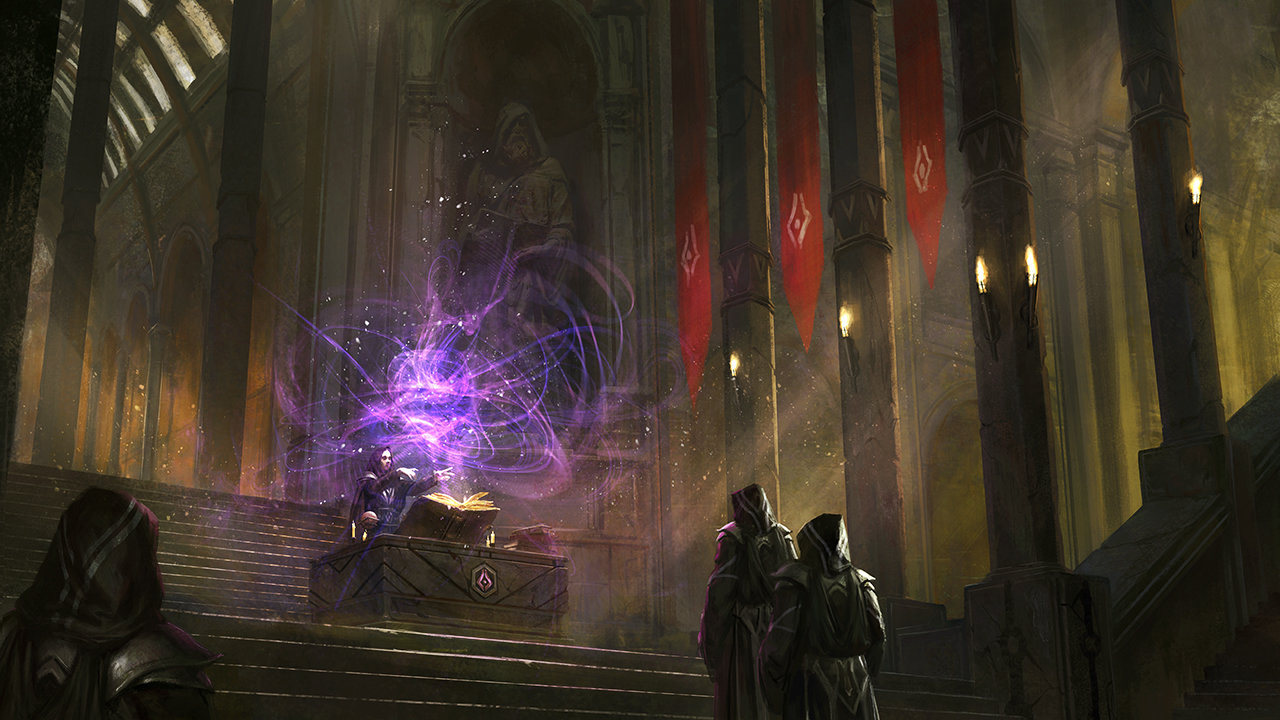- Simple - a tag will sum up the effect it has in a sentence or two. This can potentially link to other systems - if I ever publish this I will ensure links and references are included.
- Evocative - a tag's name will evoke a good sense of its effects, i.e. Irradiating, Fragile, Rending etc.
- Flexible - a PC should be able to apply and remove different tags to their equipment given the right resources, customising their kit to suit their needs.
I also planned to talk about the injury system I'll be using, as well as an outline of the psionics system that I've been mulling over, but this post became far too long.
 |
| Credit, Don Davis @ NASA Ames Research Centre |
Equipment & Tags
A tag may only be taken once per equipment item unless otherwise specified.
IMPORTANT: These are all still a work in progress and will more than likely be changed!
Base Melee Weapons
Weapons
Weapons will have a certain number of innate tags, their size for example, that cannot be changed. These tags are determined at the creation of the weapon and are usually integral to their construction or function. A weapon's size will also determine how many tags it can have applied to it. Below is a set of base weapons for each size category. Below that is a list of further tags that can be applied, their restrictions, and list of weapons that I have come up with.IMPORTANT: These are all still a work in progress and will more than likely be changed!
Base Melee Weapons
| Weapon | Size | Innate Tags | Further Tag Slots |
|---|---|---|---|
| Small Weapon | Small | Small - can be used while grappling. |
1
|
| Medium Weapon* | Medium | Medium - can be wielded in both hands for +1 damage. |
2
|
| Large Weapon** | Large | Large - must be wielded in 2 hands. |
3
|
*Spears count as medium weapons and have their stock advantages/disadvantages as per core LotFP.
**Polearms count as large weapons and have their stock advantages/disadvantages as per core LotFP.
Base Ranged Weapons
| Weapon | Size | Innate Tags | Further Tag Slots |
|---|---|---|---|
| Pistol | Small | Pistol - can be used in melee combat. |
1
|
| Rifle* | Medium | Rifle - can be used as a melee weapon with -2 to hit. |
2
|
| Heavy Weapon | Large | Heavy - takes a full round action to fire. |
3
|
| Bow** | Medium | Silent - makes no sound when fired. |
2
|
| Grenade Template*** | Small | Thrown - this weapon is designed to be thrown at a target. |
2
|
*This category covers rifles, shotguns, carbines and other two-handed firearms that don't qualify as heavy weapons.
**Note that bows will have access to a relatively small number of tags, but arrows may have one tag applied to them to allow for a number of different types.
***Grenades can be modified for different purposes, for example armour piercing grenades using the blast + hypervelocity tags, or a tear gas grenade using the gas + toxin tags. Rocket/grenade launchers are simply used for delivery purposes and have no tags of their own.
Reloading
After attacking with a ranged weapon, the wielder must roll to see if it needs reloading. To test this, roll 1d10. On a 1 the weapon must be reloaded. Bows and grenades do not make reload checks.
Further Weapon Tags
- Autoloading (non-bow ranged only) - sophisticated ammunition feeders mean reloading this weapon counts as a minor action instead of a regular action.
- Balanced (melee only) - this weapon is perfectly balanced for dual-wielding, increasing AC and hit bonuses to +2 when dual-wielding, or +1 if a large weapon. If both weapons are balanced this increases to +3.
- Beam (non-grenade ranged only) - this weapon fires an energised beam or charge and its attacks have +2 to hit but can be impaired by thick smoke or dust clouds. This weapon uses power cells instead of projectile ammo - make all reload rolls with advantage.
- Blast (grenades only) - this weapon unleashes an indiscriminate explosion that attacks AC12 or the target's base AC, whichever is lower. The weapon is irrevocably destroyed once used.
- Cryogenic (non-bow, non-hyperthermic) - shots from this weapon chill and numb their targets. The target must Save on a successful hit or be slowed for 1d6 Rounds.
- Energised (melee only) - this weapon is surrounded in a crackling halo of energy, gaining +2 to hit and damage rolls.
- Gas (non-bow, non-beam ranged only) - this weapon projects a gas instead of a solid or energy projectile. While it has a short range this gas spreads quickly and bypasses most forms of armour and cover, taking +4 to hit.
- Hyperthermic (non-bow, non-cryogenic) - this weapon superheats its targets. The target must Save on a successful hit or begin burning (see Injuries section).
- Hypervelocity (non-beam ranged only) - this weapon fires solid ammunition with terrifying power, gaining +2 to damage. Enemies behind cover take no AC bonus when targeted by this weapon.
- Ionic (non-bow) - this weapon is electrically charged and only deals 1d4 damage to organic targets, but artificial targets take double damage. Any artificial or cybernetically-enhanced target must also Save when hit or be stunned for 1d6 Rounds.
- Irradiating (non-bow) - this weapon emits harmful levels of ionising radiation. The target must Save on a successful hit or suffer +2Gy cumulative rad exposure (see Injuries section).
- Jet (non-bow, non-beam ranged only) - this weapon projects a liquid instead of a solid or energy projectile. This weapon has a moderate range and takes +2 to hit.
- Lightweight - this weapon is non-encumbering, or counts as a normal item if oversized.
- Needler (non-beam, non-bow ranged only) - this weapon fires needle-like solid projectils at a high rate of fire with very little recoil. This weapon takes +4 on hit rolls but deals 1d4 damage instead of 1d8.
- Rapid Fire (non-bow ranged only) - this weapon has a terrifying rate of fire and rolls to hit and damage with advantage, but reload rolls are made with disadvantage. This weapon can suppress targets instead of directly attacking, who must Save or take disadvantage on their next attack roll.
- Rending (non-bow) - this weapon slices and tears flesh with ease. The target must Save on a successful hit or begin bleeding (see Injuries section).
- Scattershot (non-blast ranged only) - this weapon fires multiple projectiles with a single shot, allowing the wielder to attack 2 adjacent targets with their normal combat bonus but dealing half damage to each (roll once and divide by 2, minimum 1 damage each).
- Silent (non-blast only) - attacks with this weapon make very little to no sound.
- Thrown - this weapon is designed to be thrown at a target.
- Toxic - this weapon delivers a specific poison or disease to its target. The target must Save or suffer the effects (see Injuries section).
 |
| Credit, Ariel Perez |
Armour
Armour, unlike weapons, will not have innate tags. I found it hard to think up things that weren't otherwise explained elsewhere in the LotFP rules (like encumbrance and so on) so I thought it best to leave them blank. However it will still be possible to modify armour to add and remove tags.
Base Armour
| Armour | Base AC | Tag Slots |
|---|---|---|
| Light Armour |
14
|
2
|
| Medium Armour |
16
|
3
|
| Heavy Armour |
18
|
4
|
| Shield |
+2
|
1
|
Armour Tags
- Ablative - this armour is layered with materials that divert shock and energy by vaporising or fragmenting. The first time the wearer of this armour would suffer weapon damage*, instead negate the damage and remove this tag. This tag can be taken multiple times.
- Active Countermeasures - this armour has close-in weapon capability and can intercept grenades and other thrown or slow-moving missiles. When the wearer of this armour is targeted by a thrown weapon or arrow, or if a grenade or rocket would impact within 10', they may Save as a free action to intercept it before it impacts.
- Autosenses - this armour holds integrated sensors and scanners. The wearer of this armour can sense heat and electrical signatures within 100' (if not obscured), see up to 200' away in darkness, and sense the chemical composition of the surrounding atmosphere.
- Chameleon - this armour has chameleon circuitry embedded within it, allowing the wearer to blend in to their surroundings. The wearer's Stealth skill counts as +4 while they keep perfectly still, and +2 while they are moving - every 2 points of damage suffered reduces the Stealth bonus by 1 until the armour is repaired.
- Commlink - this armour has an in-built communicator and recording apparatus capable of broadcasting up to three times the range of a handheld communicator.
- Exopowered - this armour contains layers of carbon-mesh muscle and steel sinew to enhance the strength of the wearer. The wearer of this armour counts their STR as 2 higher than normal.
- Grav-stabilisers - internal gravitic fields and gyroscopic stabilisers allow the wearer of this armour to keep their balance in nearly all situations. The wearer makes all Climb rolls and combat manoeuvre rolls to stay upright with advantage, and suffers no penalty in zero-g.
- Integrated Weaponry - this armour has an integrated melee or ranged weapon, up to medium or pistol size. The bearer cannot be disarmed of these weapons but they may not have additional tags beyond their base.
- Kinetic Dampeners - gravitic dampeners and endurance fibres allow this armour to absorb shocks and gravitational forces. The wearer of this armour will take falling damage for every 20' fallen instead of 10' and makes Saves vs g-force with advantage.
- Lightweight - this armour's encumbrance is reduced by 1, or counts as a normal item if oversized.
- Psi-Scanner - built-in psionic sensors allow the wearer a greater sensitivity to psionics. The wearer of this armour is able to detect psionic energy and psions, as well as identifying the effects of detected psionic energy.
- Psi-Warded - advanced materials, their method of construction long forgotten, line this armour and reduce the effect of psionic powers on the wearer. The wearer makes all Saves vs Psionics with advantage.
- Rad-Shielded - this armour is specifically designed to resist harmful radiation levels. The wearer of this armour makes all Saves vs Radiation with advantage.
- Radiators - this armour holds sophisticated cooling systems to vent excess heat. The wearer of this armour makes all Saves vs heat effects with advantage, but is still vulnerable to being set ablaze.
- Smokescreen - as a move action this armour can emit billowing clouds of smoke to mask its wearer. The smoke reaches up to 50' away from the wearer and the armour's reservoirs must be reloaded before it can be used again.
- Static Discharge - internal capacitors bleed off kinetic energy as a last-ditch defence mechanism. Any opponent who damages the wearer of this armour in melee must Save or suffer 1 damage from an electrical jolt.
- Survival Filters - internal filtration and reprocessing symptoms allow the wearer to survive without food or water for double the normal duration. They'll smell awful afterwards though.
- Thrusters - the wearer of this armour can jump up to three times their movement under normal gravity (which requires a Turn to cool the engines), or move at the normal movement rate with ease in zero-g.
- Trauma Kit - internal life support systems allow this armour to keep its wearer alive in cases of grievous injury. If the wearer of this armour is injured to the point where they start dying this armour automatically stabilises them for 6 hours, after which they will die if they do not receive treatment.
- Vacc-Sealed - this armour is sealed against the cold void, and is also impermeable to most airborne toxins and diseases. The internal air supply will last for 8 hours.
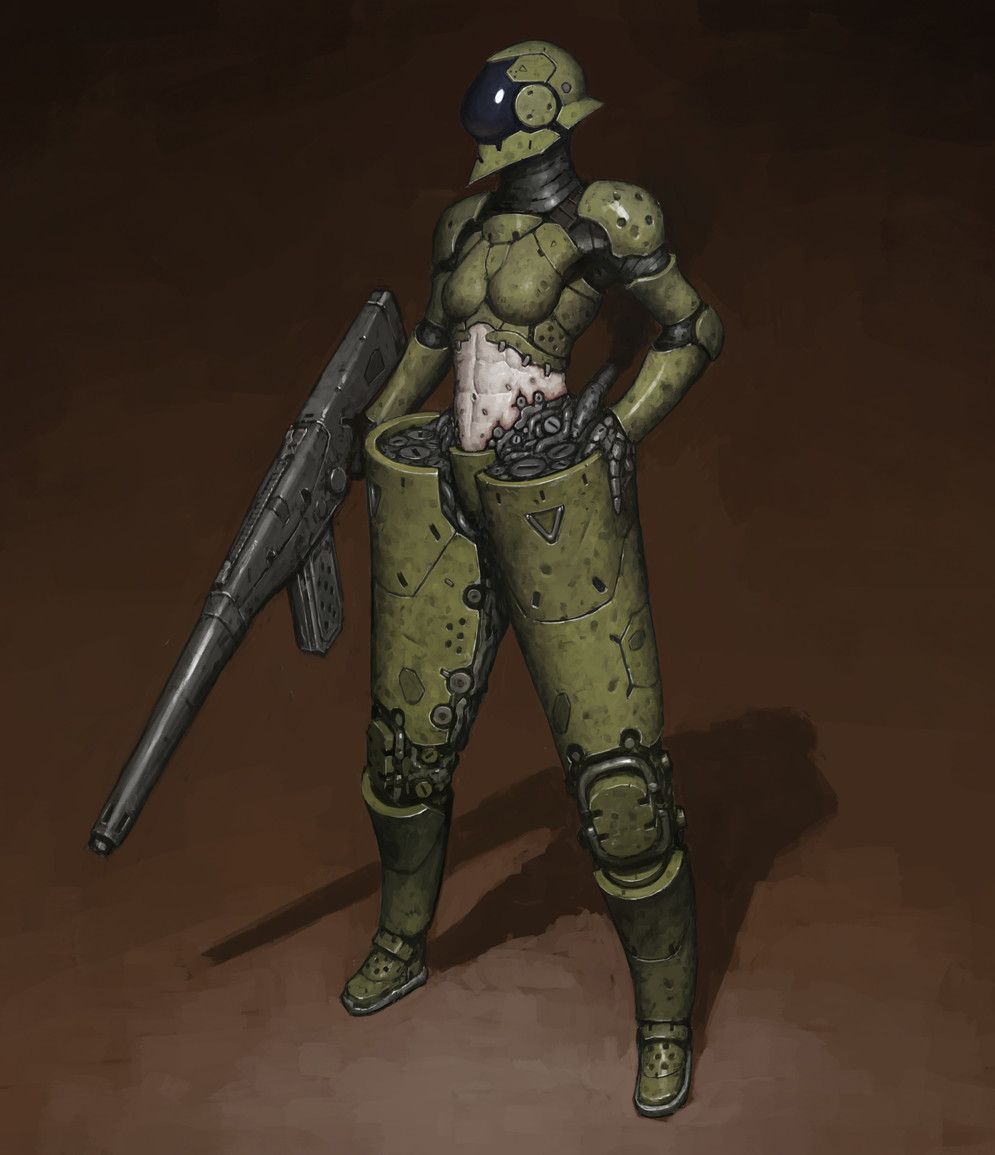 |
| Credit, Ariel Perez |
Examples
Here are a few things that I came up with using the above tags:
Ranged Weapons
Laser Pistol
Tags: pistol, beam.
Machine Pistol
Tags: pistol, rapid fire.
Silenced Pistol
Tags: pistol, silent.
Hypodermic Rifle
Tags: rifle, needler, toxic.
Combat Shotgun
Tags: rifle, autoloader, scattershot.
Survival Rifle
Tags: rifle, beam, lightweight.
Heavy Machine Gun
Tags: heavy, hypervelocity, rapid fire, scattershot.
Plasma Lance
Tags: heavy, beam, hyperthermic, rapid fire.
Cryo Cannon
Tags: heavy, cryogenic, jet, lightweight.
Melee Weapons
Charge Prod
Tags: small, ionic.
Assassin's Knife
Tags: small, toxic.
Parrying Dagger
Tags: small, balanced.
Duellist's Chainblade
Tags: medium, balanced, rending.
Hunter's Javelin
Tags: medium, balanced, thrown.
Phoenix Blade
Tags: medium, hyperthermic, lightweight.
Rad Axe
Tags: large, energised, irradiated, lightweight.
Ion Maul
Tags: large, energised, ionic, rending.
Void Lance
Tags: large, balanced, lightweight, silent.
Grenades
Frag Grenade
Tags: thrown, blast, scattershot.
Chokegas Bomb
Tags: thrown, gas, toxin.
Incendiary Grenade
Tags: thrown, blast, hyperthermic.
Rad Emitter
Tags: thrown, gas, irradiated.
Armour
Infiltration Gear (Light)
Tags: autosenses, chameleon.
Loading Apparatus (Light)
Tags: exopowered, kinetic dampeners.
Stillsuit (Light)
Tags: commlink, survival filters.
Voidsuit (Medium)
Tags: grav-stabilisers, thrusters, vacc-sealed.
Gladiator Armour (Medium)
Tags: ablative, lightweight, static discharge.
Psi-Enforcer Gear (Medium)
Tags: commlink, psi-scanner psi-warded.
Juggernaut Armour (Heavy)
Tags: active countermeasures, autosenses, integrated weaponry, smokescreen.
Reactor Suit (Heavy)
Tags: commlink, rad-shielded, trauma kit, vacc-shielded.
Mining Gear (Heavy)
Tags: exopowered, lightweight, radiators, survival filters.
